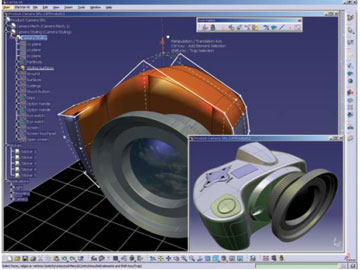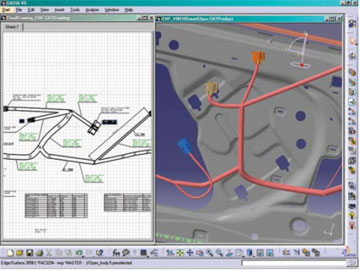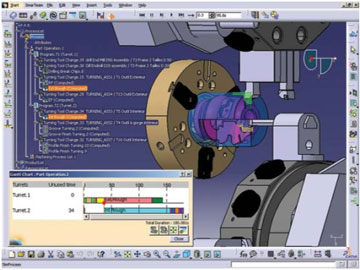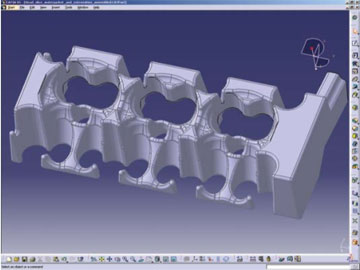| |
|
|
| |
The biggest shift for CATIA V5 relates to route to market with the release of CATIA PLM Express which include flexible solutions tailored to meet existing and future customers' day-to-day business needs. CATIA Team PLM was the core configuration of CATIA PLM Express, giving customers the CATIA modeler for product design, knowledge capture and re-use in a collaborative environment.
CATIA is configured and split into a multitude of products - 178 in total. CATIA PLM Express reduces this to 44 options, which are built on top of six different roles-Layout, Style, Mechanical, Equipment, Optimize & Review and Manufacture. Essentially, the customer choose the role appropriate to the workflow, then add-on the modules needed and mix it up with a bit of Knowledge ware tools and SmarTeam for data management – all for a lower cost.
Dassault Systemes has crammed a huge amount of technology and applications into this new release. There is a massive range of tools available to cover almost every single product development and manufacturing process. It is likely to look at what the development team has been up to in the new release to drive real innovation |
| |
| Imagine and Shape |
| |
When it comes to raw modeling technology, Imagine and Shape represents one of the most impressive innovations. The technology revolves around the use of sub-division surfaces which are interacted with within a very dynamic environment. There’s no setting up of sketch planes and little in the way of curve creation, tangency and curvature matching – one essentially start with geometric lumps and manipulate that data into the shape required.

The user has the choice of several different geometry start points – spheres, planes, cuboids and a bounding box which controls not only the form of that geometry but gives you the ability to dive in and edit edges, or vertices.
The CATIA PLM Express release sees new controls added which afford the user greater control over the forms and provides more associativity between features. Surfaces are of very high quality and can be taken through the engineering and detailing process and into manufacture. This release sees this extended with greater integration with CATIA’s Generative Shape Design tools such as Join or Extract, which allows the user to further optimize the styling to design workflow |
| |
| 3D harness design |
| |
There is an ever increasing need to be able to fully define a product in a 3D world, not only in terms of mechanical components and sub-systems, but also to incorporate electronics and electrics. Recently lot of noise has been made about the problems encountered by Airbus during the development of the A380 which relate to harness and loom design
CATIA PLM Express sees a lot of work done on the 3D electrical harness design and documentation. The new tools provide more intelligent ways of defining the routing of harnessing within a 3D product model and to ensure that those forms remain up-to-date during design changes. It also enables users to integrate the effect of gravity on the harnesses to ensure that the harness is not just an ideal, but fully manufacturable and installable.

New tools not only allow the user to reuse existing harnesses more easily, but also to ensure that the flattening of a 3D harness is more efficient. Alongside the modeling tools, of equal importance is the ability to document those harnesses, as this is the key to the whole process. The tools available to ‘Dress Up’ the drafted layouts have been improved and much of the shading, annotation of part numbers, voltages etc can be added automatically, by extracting the required information from the 3D model. |
| |
| NC machining |
| |
The expansion of CATIA’s machining capabilities has been on-going and in terms of operations and process support, there are several new machining operations. The first is plunge milling, where a new breed of cutter allows the user to rough out large portions of metal using the end of the cutter to rapidly remove greater depths of material. Elsewhere, a four-axis sweeping operation has been added to assist with both complex surface finishing and laser profiling. Finally, Tube machining has been built in.

Alongside operation expansion, this release sees the integration of both NC simulation and machine simulation, allowing you to simulate both the kinematics of your machine tool and the material removal analysis at the same time. |
| |
| Auto Fillet |
| |
For those working in Powertrain or with complex cast or injection moulded components, there is one new feature in CATIA PLM Exe that’s going to be like manna from heaven. The new Auto-filleting operation takes all of the pain out of the filleting of highly complex parts and makes it much more efficient. The ability to apply incredibly complex geometric conditions to parts in a single or much smaller number of features

The new Auto-Fillet tools allow the user to define the fillet conditions and have the system apply them where needed in a much smaller series of operations by grouping and ordering them together intelligently. Dassault Systemes has some metrics to back this up, with complex cases (such as powertrain transmission casings) seeing dramatic reduction in both time to create such features (reduced by 10 - 40%) and the number of features reduced in the order of 90%. |
| |
| 2D processes in a 3D world |
| |
Another key area for this release is the greater support for 2D-led workflows. Right from the outset, Dassault’s vision for V5 has always been about making 3D data the core, but the facts are that many industry sectors still use 2D layouts to control their working practices. The ability to derive a 3D assembly from what is essentially a 2D layout is the key to many. CATIA PLM Express sees support for this way of working introduced at a much higher level than has traditionally been the case. And the new tools allows the user to take this way of working and combine it with current technologies in 3D modeling and documentation – the ability to mix up 2D layout and annotation such as 3D tolerance to work the way the user wants, rather than having to fit your design process to how the modeling system works. |
| |
| In conclusion |
| |
This paper barely touched on what’s been added and enhanced within the CATIA PLM Express, but these are the highlights. There is more in this release that relates to the integration of physical forms with updated reverse engineering tools that allows one to mix and match scanned and surface data – there’s also been work done on functional modeling, which is a whole other subject in itself.
EDS Technologies is playing an active roll with Dassault Systemes to bring value to its existing customer base and the emerging SMB segment in the country through CATIA PLM express.
For more details about the CATIA PLM express, please feel to get in touch with any of our regional offices across six cities in India or send your requests to - marketing@edstechnologies.com |
|
|
|
